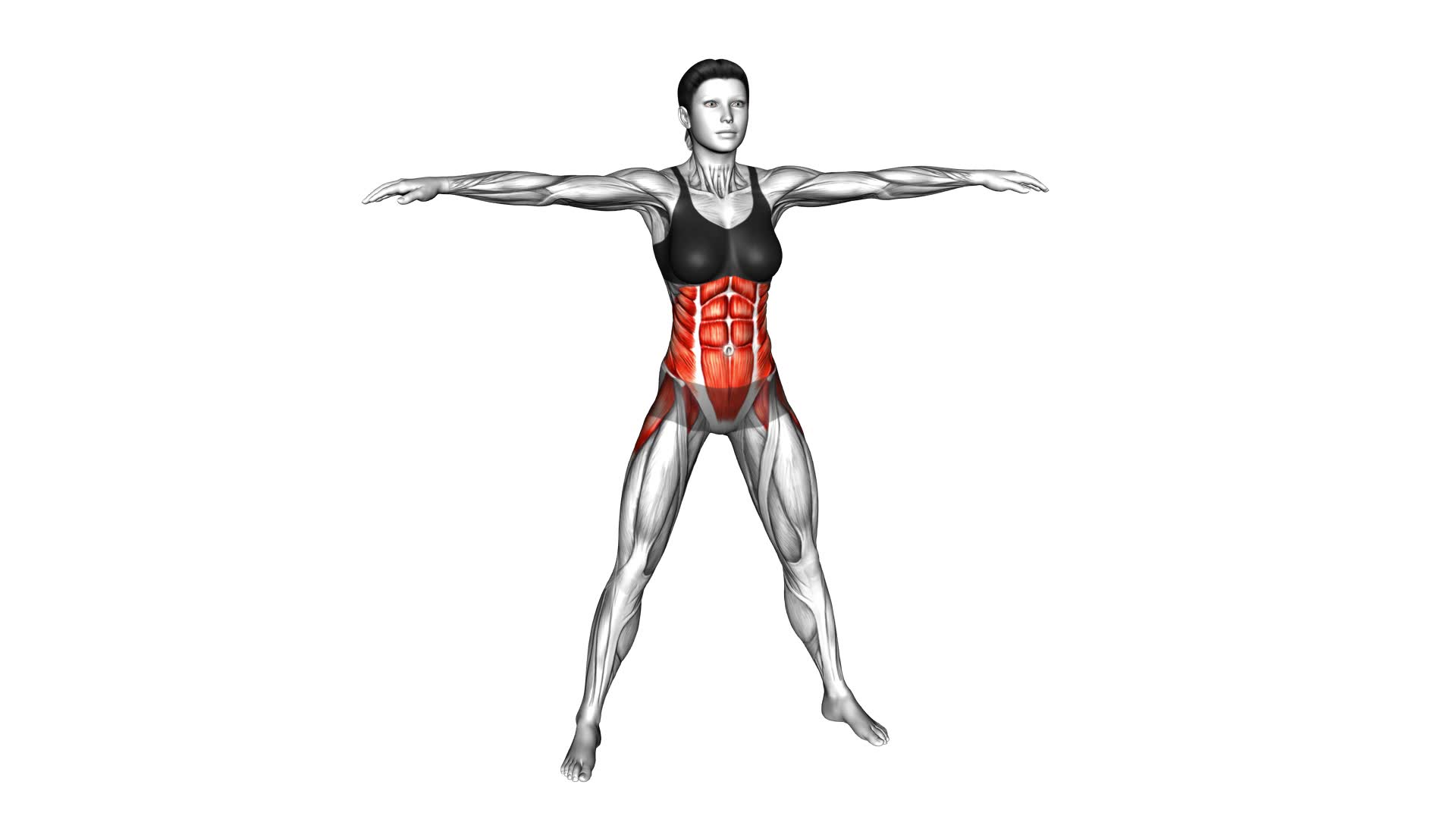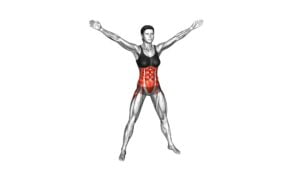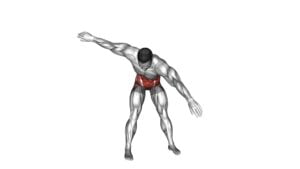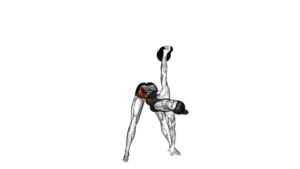Bodyweight Windmill (female) – Video Exercise Guide & Tips

Are you looking for a effective full-body exercise that you can do anywhere? Look no further than the bodyweight windmill!
Watch This Exercise Video
In this video exercise guide, we'll show you the proper form and technique to maximize your results. Whether you're a beginner or more advanced, we'll also provide modifications and progressions to challenge you at any level.
Say goodbye to common mistakes and hello to a stronger, more flexible you. Let's get started!
Key Takeaways
- The Bodyweight Windmill enhances flexibility, builds core strength, improves stability and posture, and targets multiple muscle groups.
- Proper form and technique involve starting with feet shoulder-width apart, engaging core muscles for stability, maintaining a neutral spine, and paying attention to body signals and discomfort.
- Modifications and progressions include using lighter weight or no weight, gradually increasing weight as strength improves, incorporating a kettlebell or dumbbell, performing on an unstable surface, and combining with other exercises.
- Common mistakes to avoid are incorrect positioning and alignment, rushing through the exercise, rounding the back or hunching the shoulders, and neglecting proper breathing technique.
Benefits of the Bodyweight Windmill
Get stronger and more flexible with the Bodyweight Windmill. This exercise isn't only great for building core strength but also for improving flexibility. By incorporating the Bodyweight Windmill into your workout routine, you can experience a range of benefits.
One of the main advantages of the Bodyweight Windmill is its ability to enhance flexibility. As you perform the exercise, you engage your muscles and stretch them, which helps to increase your overall flexibility. This can be particularly beneficial for athletes or individuals who participate in activities that require a wide range of motion.
Additionally, the Bodyweight Windmill is a fantastic exercise for building core strength. As you rotate your body and extend your arms, you activate your core muscles, including the abdominals, obliques, and lower back. These muscles work together to stabilize your body and maintain proper form throughout the movement. By consistently performing the Bodyweight Windmill, you can strengthen your core, leading to improved stability and posture.
Incorporating the Bodyweight Windmill into your workout routine can help you achieve improved flexibility and core strength. Whether you're an athlete looking to enhance performance or simply want to boost your overall fitness level, this exercise is a valuable addition to any routine.
Proper Form and Technique
To perform the Bodyweight Windmill correctly, follow these steps.
- Start by standing with your feet shoulder-width apart.
- Extend your right arm overhead and slightly tilt your body to the left.
- Keep your left arm extended downward and your left leg straight.
- Begin the movement by hinging at your hips and lowering your torso towards the ground.
- As you reach the bottom position, try to touch the ground with your left hand while keeping your right arm extended overhead.
- Engage your core muscles throughout the movement to maintain stability and control.
- To return to the starting position, push through your left foot and use your core strength to lift your torso back up.
- Repeat the exercise for the desired number of repetitions and then switch sides.
Proper form and technique are crucial when performing the Bodyweight Windmill.
- It's important to maintain a straight line from your head to your toes throughout the movement.
- Keep your core engaged to prevent any excessive twisting or bending.
- It's also essential to perform the exercise at a controlled pace, focusing on the quality of each repetition rather than the quantity.
There are several variations of the Bodyweight Windmill that you can incorporate into your workout routine.
- You can use a kettlebell or a dumbbell to add resistance to the exercise, making it more challenging.
- Another variation is the Side Plank Windmill, where you start in a side plank position and perform the windmill movement with your upper arm extended overhead.
- These variations can help target different muscles and add variety to your training routine.
- Remember to always listen to your body and choose the variation that works best for you.
Modifications and Progressions
Once you have mastered the proper form and technique of the Bodyweight Windmill, you can explore modifications and progressions to challenge yourself further.
Modifications allow you to adjust the exercise to your current fitness level, while advanced variations provide an extra challenge as you become more proficient in the movement.
One modification you can try is using a lighter weight or no weight at all. Instead of holding a dumbbell or kettlebell in your hand, keep your arm extended overhead without any additional resistance. This will still engage your core and shoulders, but with less intensity.
To progress the Bodyweight Windmill, you can incorporate more dynamic movements. Instead of performing the exercise in a slow and controlled manner, you can add a jump or hop as you transition from one side to the other. This will increase the cardiovascular demand and add an explosive element to the exercise.
Another advanced variation is to perform the Bodyweight Windmill on an unstable surface, such as a BOSU ball or a balance board. This will challenge your stability and force your core muscles to work even harder to maintain balance throughout the movement.
Common Mistakes to Avoid
To ensure proper form and maximize the effectiveness of the Bodyweight Windmill, it's crucial that you avoid common mistakes. By avoiding these mistakes, you can prevent injury and ensure that you're getting the most out of this exercise.
Here are some common mistakes to watch out for:
- Incorrect positioning: One common mistake isn't maintaining proper alignment throughout the movement. It's important to keep your feet hip-width apart and your core engaged. Make sure to keep your shoulders stacked over your hips and your gaze forward to maintain proper form.
- Rushing the movement: Another common mistake is rushing through the exercise. Slow and controlled movements are key to getting the most benefit from the Bodyweight Windmill. Take your time and focus on engaging the appropriate muscles throughout the entire range of motion.
By being mindful of these common misconceptions, you can avoid potential pitfalls and ensure that you're performing the Bodyweight Windmill correctly.
Now, let's move on to some tips for maximizing your results and taking your workout to the next level.
Tips for Maximizing Results
To maximize your results and take your workout to the next level, continue focusing on proper form and avoiding common mistakes in the Bodyweight Windmill exercise. One common misconception is that this exercise only targets the core. While it's true that the Bodyweight Windmill primarily engages the core muscles, it also works the shoulders, hips, and glutes. By maintaining proper form throughout the movement, you can ensure that all of these muscles are effectively targeted and strengthened.
Another tip for maximizing results is to perform the Bodyweight Windmill at the best time during your workout. It's recommended to incorporate this exercise into your warm-up routine. This will help activate the muscles and prepare your body for more intense movements. Additionally, performing the Bodyweight Windmill early in your workout can help improve your overall mobility and flexibility.
To ensure that you're getting the most out of this exercise, it's important to pay attention to your body and listen to any discomfort or pain. If you experience any discomfort, it's recommended to stop and consult with a fitness professional. Remember to always start with a weight that challenges you but allows you to maintain proper form.
With consistent practice and attention to detail, the Bodyweight Windmill can be a valuable addition to your workout routine, helping you achieve your fitness goals.
Frequently Asked Questions
Can the Bodyweight Windmill Help With Improving Flexibility?
Yes, the bodyweight windmill can definitely help improve flexibility. By incorporating this exercise into your routine, you'll not only work on your balance and core strength but also stretch and lengthen your muscles.
The twisting motion involved in the windmill movement helps to increase range of motion, while the engagement of your core muscles helps to stabilize your body throughout the exercise.
This combination of flexibility and strength training can lead to improved overall flexibility.
How Many Repetitions of the Bodyweight Windmill Should I Do for Optimal Results?
To achieve optimal results with the bodyweight windmill, it's important to consider your current fitness level and goals. Start by focusing on improving core strength, which is the main benefit of this exercise.
Beginners can modify the bodyweight windmill by performing fewer repetitions and using a lighter load. As you progress, gradually increase the number of repetitions to challenge your muscles and continue improving.
Remember to listen to your body and consult with a fitness professional if needed.
Can the Bodyweight Windmill Be Performed by Individuals With Lower Back Pain?
If you have lower back pain, you may wonder if you can do the bodyweight windmill.
The bodyweight windmill can be modified to accommodate individuals with lower back pain. By focusing on proper form and using modifications like reducing the range of motion or using a smaller weight, you can still reap the benefits of this exercise.
The bodyweight windmill helps strengthen and stabilize your core, which can be beneficial for individuals with lower back pain.
Is It Necessary to Warm up Before Attempting the Bodyweight Windmill?
Before attempting the bodyweight windmill, it's important to warm up. Dynamic warm up exercises have numerous benefits, such as increasing blood flow, improving flexibility, and reducing the risk of injury.
For beginners, there are modifications available for the bodyweight windmill. These modifications can help you gradually build strength and improve your form.
Remember to start with a proper warm up to prepare your body for this exercise.
Can the Bodyweight Windmill Be Incorporated Into a Full-Body Workout Routine?
Yes, the bodyweight windmill can be incorporated into a full-body workout routine. It's a challenging exercise that engages multiple muscle groups, promoting strength and stability.
Beginners can modify the movement by using a lighter load or performing the exercise without weights.
Advanced athletes can increase the difficulty by using a heavier load or adding variations, such as a kettlebell or dumbbell.
Adding the bodyweight windmill to your routine can help you achieve a well-rounded, effective workout.
Conclusion
In conclusion, the bodyweight windmill is a powerful exercise that offers numerous benefits, including improved core strength, flexibility, and stability.
By maintaining proper form and technique, you can maximize the effectiveness of this exercise and avoid common mistakes.
With modifications and progressions, you can tailor the bodyweight windmill to suit your fitness level and continue challenging yourself.
Remember to follow these tips for optimal results and enjoy the many advantages this exercise has to offer.

Author
Years ago, the spark of my life’s passion ignited in my mind the moment I stepped into the local gym for the first time. The inaugural bead of perspiration, the initial endeavor, the very first surge of endorphins, and a sense of pride that washed over me post-workout marked the beginning of my deep-seated interest in strength sports, fitness, and sports nutrition. This very curiosity blossomed rapidly into a profound fascination, propelling me to earn a Master’s degree in Physical Education from the Academy of Physical Education in Krakow, followed by a Sports Manager diploma from the Jagiellonian University. My journey of growth led me to gain more specialized qualifications, such as being a certified personal trainer with a focus on sports dietetics, a lifeguard, and an instructor for wellness and corrective gymnastics. Theoretical knowledge paired seamlessly with practical experience, reinforcing my belief that the transformation of individuals under my guidance was also a reflection of my personal growth. This belief holds true even today. Each day, I strive to push the boundaries and explore new realms. These realms gently elevate me to greater heights. The unique combination of passion for my field and the continuous quest for growth fuels my drive to break new ground.







